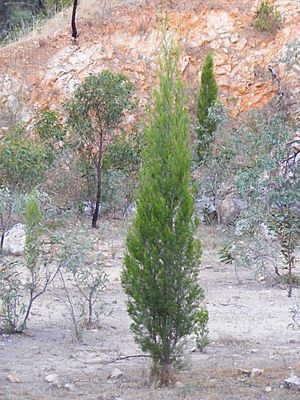Rottnest Island pine facts for kids
Quick facts for kids Rottnest Island pine |
|
|---|---|
 |
|
| Callitris preissii sapling in Adelaide, South Australia | |
| Conservation status | |
| Scientific classification | |
| Genus: |
Callitris
|
| Species: |
preissii
|
| Synonyms | |
|
|
The Callitris preissii is a special type of conifer tree. It belongs to the Cupressaceae family, which includes many well-known cypress trees. This tree is native to Rottnest Island in Australia.
People call this tree by many names. Some common names are Rottnest Island pine and Murray pine. It is also known as maroong, southern cypress pine, or slender cypress pine. The Noongar people, who are the traditional owners of the land, call this tree marro.
Contents
What Does the Rottnest Island Pine Look Like?
This unique pine can grow as a tree or a shrub. It usually reaches a height of 1 to 9 meters (about 3 to 30 feet). It can also spread out, growing up to 6 meters (about 20 feet) wide. It grows quite slowly, taking its time to get big.
Leaves and Cones of the Cypress Pine
The top part of the tree, called the crown, is often full of fine, thick leaves. Each leaf is rounded on its back side. The cones of this tree are usually more than 2 centimeters (about 0.8 inches) wide. Unlike some other cones, their scales do not easily separate from the base.
The Callitris preissii starts to produce its cones between October and January. These cones are a mix of brown, yellow, and orange colors. The tree's roots can be moderately deep or spread out close to the surface. This tree can live for a long time, often more than 15 years.
Where Does the Murray Pine Grow?
The Callitris preissii is naturally found in specific areas of Western Australia. These areas include the Swan Coastal Plain, Rottnest Island, and Garden Island. However, it has also started to grow in other places.
Natural Habitat and Spread of the Cypress Pine
Today, you can find this tree scattered across many regions. These include the Mid West, Wheatbelt, Peel, Great Southern, and Goldfields-Esperance regions. It likes to grow on flat plains, hillsides, and near the edges of salt lakes. You might also see it among large granite rocks. It can grow in different types of soil, including sandy, loamy, or clay soils.
How Do People Use This Tree?
The Callitris preissii is a very useful plant. Farmers often use it to create a windbreak. This means planting a line of these trees to protect fields or animals from strong winds. It also provides shelter and shade for farm animals.
Practical and Decorative Uses of the Tree
The strong trunks of these trees are perfect for making fence posts. This tree also looks very nice, so people use it for decoration. Its pollen is valuable for beekeeping, helping bees make honey. In towns and cities, it makes a good ornamental plant. It can be planted as a free street tree or used to create a screen or hedge around properties.
See also
 In Spanish: Callitris preissii para niños
In Spanish: Callitris preissii para niños


